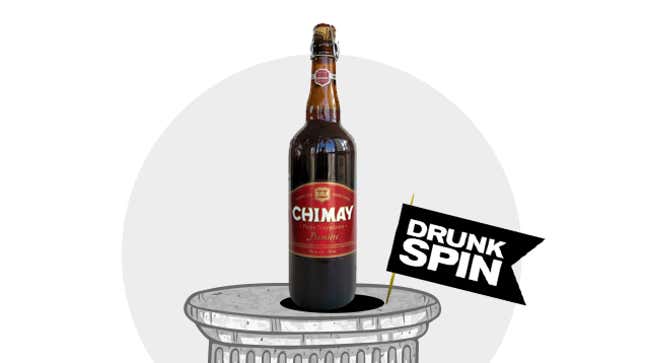
This morning, while combing through the Drunkspin archives to see how many times I’ve said “mouthfeel” so as to determine how many pushups I owe the Non-Creepy Food and Drink Bloggers Guild, I realized that we’ve covered perilously few foreign beers here. And we’ve said shitty things about most of the handful we have deigned to feature. Is Drunkspin a nativist beer blog?
I guess, but not intentionally. We don’t cover a lot of beer from other countries for the same shitty but valid reason we focus disproportionately on beer from the coasts and specifically New England: It’s easier to come by. I live in Massachusetts, and our other correspondents live in, like, New Mexico and Denver or thereabouts; we review what we can get our hands on. And the vast majority of beer imported into America is either mass-produced, heavily marketed, lightly flavored swill (Heineken, Corona) or potentially good stuff that doesn’t sell briskly enough to trust that you’re ever getting a fresh sample.
There’s a new-to-us New Zealand brewery called Moa that gets good reviews and ships over some interesting-looking stuff, but I haven’t pulled the trigger yet, because I have no way of knowing just how patiently a given bottle’s been waiting for me. First and foremost, I don’t want to waste any of my soft-earned riches on subprime beer, and I also don’t want to pass bad intel along to you guys.
But things are starting to look up lately on the import front, with more breweries around the world willing to ditch their iconic-but-barbaric green and clear glass bottles in favor of brown bottles (better) or cans (best). Just this March, I was able to have the first good Pilsner Urquell of my life, from a gorgeous 16-ounce can that got me rethinking my stance against international beer tourism. I’d previously suspected all the “You’ve got to get to Oktoberfest one year” and “Oh, man, you can’t judge Czech beer until you’ve tried it fresh at the source” stuff was one part truth to two parts romanticism and bragging. Now I’m willing to consider that the real ratio might be closer to a reason to renew my passport.
Belgium is one country we’ve long been able to look to for high-quality imported beer (Stella Artois notwithstanding). This is partly because the beer’s so good to begin with that it can suffer a slight degradation and still be plenty fine enough for the likes of you and me, and partly because a lot of the Belgian beers shipped to America tend to be higher-alcohol, less-hoppy, bottle-conditioned numbers that can withstand a bit more wear and tear than the light lagers that make up the bulk of our cruddy imports.
The most famous Belgian beers are made by the Trappist abbeys; you can read all about the magical monk juice here. My favorite is Chimay Première, which I recommend not for its history or provenance, both of which are pretty cool stories, but because it is better than any American version of Belgian-style dubbel ale I’ve tried. In fact, Première, also known as Red Cap, is the most consistently excellent imported beer I know of, as my beloved Conniston Bluebird Bitter often arrives in my glass after a bit too much rest oN the shelf.
Chimay Première is a deep amber with red highlights and very active carbonation (though the bubble factor will vary depending on the beer’s age). It has a great, big, pillowy off-white head that quickly deflates but never disappears. The aroma is a complex blend of yeast esters (mostly banana), dark fruit, and spice. There’s some brown sugar, molasses, and caramel flavor up front, along with a slightly boozy plum-wine note that deepens the generally fruity malt. The spicy clove and black pepper last throughout, lending a more austere edge to a style that I sometimes find too sweet.
For around $10 for a 750-milliliter bottle, Chimay Première (7 percent alcohol-by-volume) is one of the rare imported beers that offers American drinkers a consistently great experience that can’t be replicated by a cheaper domestic version.
This is Drunkspin Daily, the Concourse’s adequate source for booze news, reviews, and bullshit. We’ll be highlighting a beer a day in this space; please leave suggestions below.
Image by Jim Cooke.
Will Gordon loves life and tolerates dissent. He lives in Cambridge, Mass., and some of his closest friends have met Certified Cicerones. Find him on Twitter @WillGordonAgain.